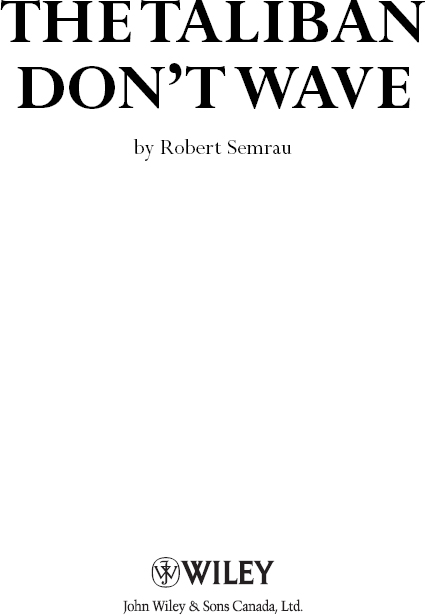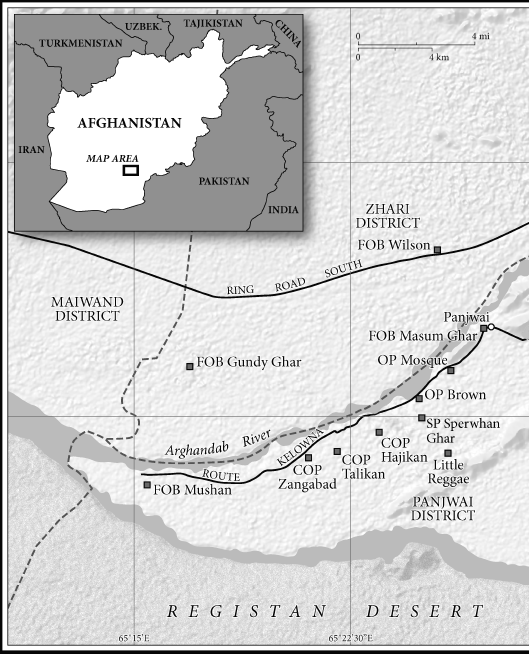The Taliban Don't Wave
Read The Taliban Don't Wave Online
Authors: Robert Semrau



Copyright © 2012 Robert Semrau
All rights reserved. No part of this work covered by the copyright herein may be reproduced or used in any form or by any meansâgraphic, electronic or mechanical without the prior written permission of the publisher. Any request for photocopying, recording, taping or information storage and retrieval systems of any part of this book shall be directed in writing to The Canadian Copyright Licensing Agency (Access Copyright). For an Access Copyright license, visit
www.accesscopyright.ca
or call toll free 1â800â893â5777.
For general information about our other products and services, please contact our Customer Care Department within the United States at (800) 762-2974, outside the United States at (317) 572-3993 or fax (317) 572-4002.
Wiley publishes in a variety of print and electronic formats and by print-on-demand. Some material included with standard print versions of this book may not be included in e-books or in print-on-demand. If this book refers to media such as a CD or DVD that is not included in the version you purchased, you may download this material at
http://booksupport.wiley.com
. For more information about Wiley products, visit
www.wiley.com
.
Care has been taken to trace ownership of copyright material contained in this book. The publisher will gladly receive any information that will enable them to rectify any reference or credit line in subsequent editions.
Names have been changed to protect allies and sources, and others in the field whose combat role may extend beyond Afghanistan.
Library and Archives Canada Cataloguing in Publication
Semrau, Robert
The Taliban don't wave / Robert Semrau.
ISBN 978-1-11826-118-7 (print); 978-1-118-26160-6 (ebk); 978-1-118-26155-2 (ebk); 978-1-118-26147-7 (ebk)
1. Semrau, Robert. 2. Afghan War, 2001âPersonal narratives, Canadian. 3. Afghan War, 2001âParticipation, Canadian. 4. CanadaâArmed ForcesâAfghanistan. 5. SoldiersâCanadaâBiography. I. Title.
DS371.413.S44 2012Â Â Â 958.104'7092Â Â Â C2012-904132-7
Production Credits
Cover design: Adrian So
Cover images: Robert Semrau
Interior design: Mike Chan
Managing Editor: Alison Maclean
Production Editor: Lindsay Humphreys
Composition: Thomson Digital
John Wiley & Sons Canada, Ltd.
6045 Freemont Blvd.
Mississauga, Ontario
L5R 4J3
For Amélie, Caméa, and Chloé; and to the men and women, both living and the honoured dead, who served in Afghanistan.


Foreword
With the exception of members of our elite JTF2 special forces, who were inserted earlier, Canadian soldiers deployed to Afghanistan some five months after the attacks of 9/11. This tardy deployment was the result of an embarrassing lack of Canadian strategic airlift, which chronically required us to beg a lift with the US Air Force or charter exorbitantly expensive Russian or Ukrainian resources. During this painful wait for a ride, the 3 PPCLI battle group had to cool its heels at its base in Edmonton.
The mission for the first allied units that arrived in Afghanistan was to take down al Qaeda and to assist the indigenous Afghan forces as they replaced the repressive Islamist Taliban regime, which had taken over the country in 1998 following the withdrawal of the Russian military in 1989 and the ensuing civil war. This mission was achieved within months in 2002.
When a dog chases a school bus, it's really funâuntil he catches it. That's when the hard part begins, as he must decide what to do with it. The initially US-led deployment of allied forces to Afghanistan faced the same dilemma in 2002. Their mission had been accomplished, but they had “caught” Afghanistan, one of the poorest and most war-ravaged countries on the face of the earth. High-level international meetings were convened to determine, or at least assist with, Afghanistan's future, and terms like governance, education, healthcare, female rights, poppy eradication, and any number of additional projects related to nation building became part of the new strategy. The allied militaries involved in the operation immediately recognized the inevitable “mission-creep.”
While those focusing on nation building got on with their part of the pie, the military was forced to take on an increasingly capable Taliban insurgency. It didn't take a rocket scientist to determine that international military forces wouldn't, and couldn't, stick around forever fighting someone else's war. As a result, part of the military's effort was deflected to numerous Provincial Reconstruction Teams (PRTs), building roads, schools, police stations, and the like. Recognizing the need to create an Afghan army capable of containing the insurgency once the inevitable allied withdrawal took place, the concept of allied mentoring of fledgling Afghan army units was introduced, along with the somewhat humorous acronym OMLT (pronounced
omelette
), standing for Operational Mentor and Liaison Team.
The OMLT teams were small, averaging only four or five members each and usually consisting of an officer, a warrant officer, and two non-commissioned members. Their contribution to the Afghan campaign was kept low-key because the media realized the unpredictable nature of their work and the inherent danger, so they wisely rarely accompanied them into battle. The OMLT teams themselves were limited to advising their Afghan counterparts, no matter how incompetent they might be, and, bearing in mind cultural sensitivities, could not take charge of a failing mission no matter how disastrous the situation. On the positive side, they could request allied resources, including fast air and attack helicopters, artillery and mortars, and unmanned aerial vehicles to support their counterparts' mission, although there was no guarantee of availability.
It is one thing to be an advisor to an Afghan unit in support or, to use the accepted term, “inside the wire,” but quite another to accompany a unit regularly tasked to make contact with the Taliban. You would be acutely aware that your life was in the hands of someone who, if he had the necessary skills to lead in combat, wouldn't need you along as an advisor.
In August of 2008, Captain Robert Semrau found himself in charge of such a team attached to a unit of the Afghan army. During one particularly risky patrol, his Afghan unit was ambushed by a superior Taliban force. A NATO attack helicopter gunship was called in to provide support, and bursts of 30mm rounds (the length of a beer can and the diameter of a large carrot) delivered at a rate of over ten rounds a second, 625 per minute, devastated a significant component of the Taliban opposition. When Captain Semrau and his team arrived on the scene, the partial remains of Taliban victims littered the area. At one particular moment Captain Semrau wondered why a string of sausages was hanging from the limb of a tree, until he realized it was someone's intestines. Nearby was a mortally wounded Taliban who was, for all intents and purposes, cut in half with a hole, by some accounts the size of a dinner plate, through his midsection. Blood and what was left of his internal organs were splattered on the ground around him. To add to the man's agony, another round had shattered one of his legs. Afghan soldiers passing the scene commented that “Allah will look after him” and moved on; some were later accused of kicking the victim.
Captain Semrau's description of what happened next takes less than ten seconds to read and, interestingly, that was probably the amount of time he had to decide what to do before catching up to his Afghan counterpart. Witnesses indicated that he fired two rounds into the dyingâor deadâTaliban fighter, the act subsequently described by the media as a “mercy killing.” Some seventeen months later, it took a court martial seven months to investigate, dissect, and analyze those ten seconds, and to determine that this officer with a sterling reputation as a soldier and a leader should no longer be allowed to serve in the Canadian Forces.
The high-profile court martial of Captain Semrau highlighted, in the eyes of many, including yours truly, a deficiency in the court martial procedures within the Canadian Forces.
Until the late 1980s, in general army officers conducted courts martial for army officers, air force officers tried their own, and the navy did the same, usually with a member of one of the other services included as a jury member, an “honest broker.” In order to withstand Charter challenges regarding the independence of military courts, a Court Martial Administrative Office was established. While it was a positive move to preclude such challenges, there was a serious downside. The new pool of eligible personnel for court martial duty was massive. As an example, if two lieutenant colonels were needed for a court martial panel, every commander (equivalent to lieutenant colonel) in the navy and every lieutenant colonel in both the army and the air force was eligible. In order to select members, a random selection process was necessary.
In the case of Captain Robert Semrau, the panel initially consisted of a navy commodore (equivalent to brigadier-general), an army lieutenant-colonel, two air force majors, and an army captain. For reasons known only to himself, the army lieutenant colonel withdrew from the panel as all members were about to depart for Afghanistan for deliberations at the site of the incident.
What follows is in no way a criticism of the individual panel members, but rather of a system that needs to recognize and deal with a serious shortcoming.
No one on Semrau's panel had any background in combat operationsâand I'm not just referring to combat itself. I include the study of combat and basic training for land combat. During their deliberations it would have been extremely helpful and dare I say, essential, to have at least one individual who could attempt to explain the context of those ten seconds they were dealing with.
The findings of not guilty of second-degree murder, attempted murder, and negligent performance of duty were well founded. The finding of disgraceful conduct as a catch-all can be understood to appease those who didn't understand the context and wanted some form of punishment; however, release from the Canadian Forces was inappropriate. Many, including friends of mine currently holding senior positions within the Canadian Forces, opined that the release was necessary to deter future incidents and send a message to serving soldiers. I strongly disagree. When a soldier is faced with a similar situation in some far-flung battlefield in the future and has those ten seconds to reach a decision, no regulation nor memory or knowledge of Captain Rob Semrau's court martial will spring to mind. It will be his or her own moral code that will dictate their responseânothing more, nothing less.
By the way, you might wonder where the title
The Taliban Don't Wave
came from. I was going to tell you but changed my mindâkeep reading.
Lewis W. MacKenzie, CM, OOnt, MSC and Bar, CD
Major-General (Ret'd)